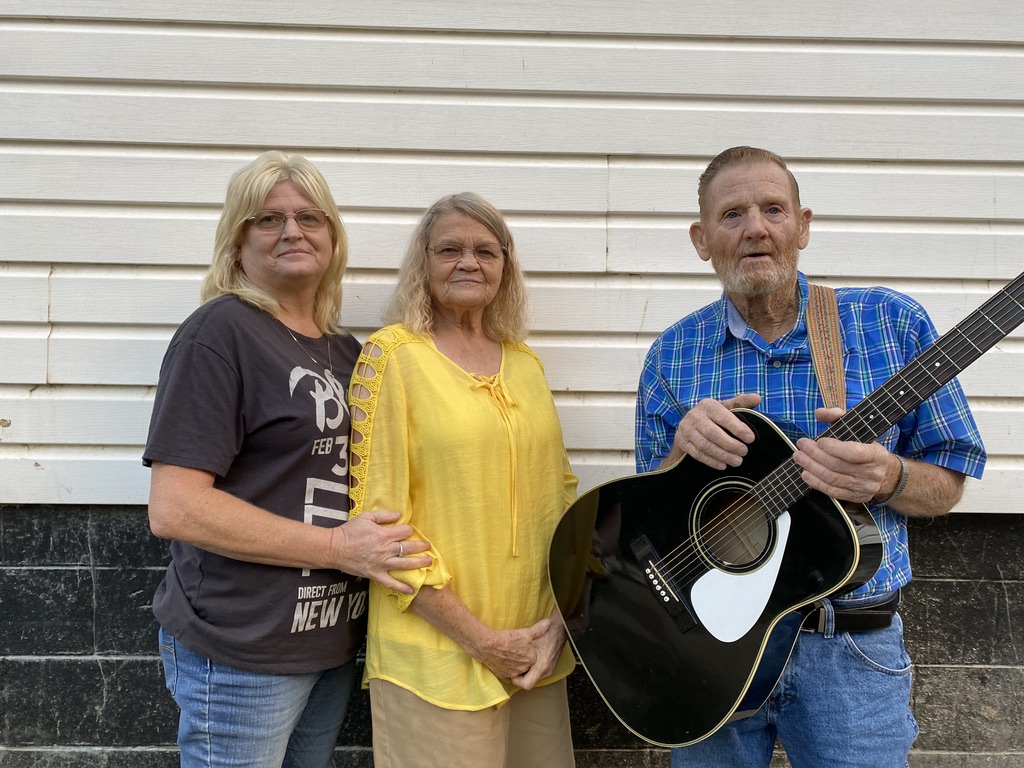This story originally aired in the March 5, 2023 episode of Inside Appalachia.
On July 28, 2022 — the day of the flood — James and Ruby Boggs had about four and a half feet of water rushing through their two-story house. They live in an old coal camp called Millstone. It sits on the North Fork of the Kentucky River, and it was one of the communities hit hard by the flood.
I was here a few weeks after the flood with a volunteer group. We helped tear out drywall and flooring with the Boggs’ daughter, Derenia Dunbar. I returned a month later, and Derenia took me inside to show me their progress.
“We had this donated to us and this donated to us,” Derenia said, pointing to a pile of insulation and drywall. “Just got it yesterday.”
Derenia is in her fifties and grew up in this house. Music was always a part of daily life for the family. And it remains important today.
“When we have Thanksgiving, we have Christmas, anything, we all start singing. It’s all music,” Derenia said. “I got a brother that plays the harmonica. I sing, my other brother sings and plays guitar. Now I have a granddaughter who’s picking up the guitar and playing. And she can yodel, like my dad. She can.”
Derenia’s parents were part of a well-known gospel group in the area called The Happy Notes. The Happy Notes played on the local radio station, and at funerals and revivals. They even recorded an 8-track that Derenia sang on.
Derenia’s parents, James and Ruby, are in their seventies now. And they don’t perform as much as they used to. Lately, Ruby’s voice has started giving out.
“I’ve actually wore my voice out where we’ve sang so much for so many years,” Ruby said. “And I’m not ashamed to say that when I get anointed, I’m very loud.”
But James and Ruby still sing and play at their church and with family. So when their house filled with flood waters, one of the things they were most worried about was James’ guitar.
“Forty-seven years we lived here and we lost everything downstairs. My guitar was in here,” James said.
The guitar was downstairs, in a case propped up in a corner of the living room.
“I figured it was destroyed,” James said.
When the water receded, James spotted the guitar case in all the mess. It fell apart as soon as he opened it. He pulled the guitar out and looked it over. There was a little mud on the neck and the strings needed to be replaced. But it wasn’t warped or cracked. So James decided to give it a test.
“I said, ‘Oh Lord, have mercy, Ruby.’ I said, ‘If it rings, it’ll be alright.’ So I got it and…it rang! I said, ‘Thank you, Lord,'” James explained.
Even though the guitar rang, Derenia said that it still needed some work.
“My younger brother, Dewryan, took it to his house and cleaned it and shined it. Put all brand new strings on it. And the case that he had that fell apart, we just got rid of it, and my brother got him a case and put the guitar in it,” Derenia said.
A couple of weeks later, the whole family gathered outside the family home to celebrate James’ 79th birthday. And they presented James with the spruced up guitar. Surprised and delighted, James tuned it up and led four generations in a rendition of “I’ll Fly Away.” Someone in the family recorded the moment and shared it to Facebook.
“They was all singing tenor and low tenor and all this stuff, so all of us was singing the song,” Derenia said. “And we just enjoyed it. It was just a really awesome time.”
Derenia said some people were surprised that her family was able to express so much joy amidst the hardship.
“People started responding to it and saying that we were singing joyful songs, and the flood was behind us. We had all the debris outside, and everybody was saying, ‘It’s a time that you all have joy when most people don’t got that joy.’ But I know that it all come from God,” Derenia said.
In the aftermath of the flood, singing together has been a source of comfort for the Boggs family. And as Ruby explained, it is also a way to reaffirm their faith after tragedy.
“Singing has always been a joy,” Ruby said. “When I sing, and I feel God’s love and His mercy, I know that he’s with me.”
Seven months after the flood, James and Ruby are still waiting to move back into their home. The family has been navigating some illnesses, so rebuilding has taken longer than they had hoped. But they’ve hung sheetrock on the walls, and a local nonprofit helped get them a new heat pump at no cost. A friend of theirs is a carpenter, and he has been helping on weekends.
They hope to move back in in two to three months — before the one-year anniversary of the flood.
——
This story is part of the Inside Appalachia Folkways Reporting Project, a partnership with West Virginia Public Broadcasting’s Inside Appalachia and the Folklife Program of the West Virginia Humanities Council.
The Folkways Reporting Project is made possible in part with support from Margaret A. Cargill Philanthropies to the West Virginia Public Broadcasting Foundation. Subscribe to the podcast to hear more stories of Appalachian folklife, arts and culture.
